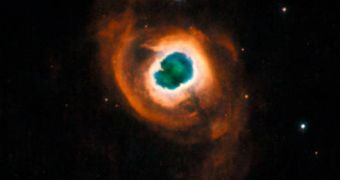With space shuttle Atlantis en route to repair and upgrade it, the Hubble Space Telescope must now say goodbye to its longest-running optical camera, the Wide Field Planetary Camera 2 (WFPC2), which will be decommissioned over the next few days. In honor of the device, which has shown us the Universe for what it really is for more than 17 years, mission controllers have captured the last picture of a planetary nebula to be taken with the old instrument. The Kohoutek 4-55 (K 4-55) formation is located in the Cygnus constellation, approximately 4,600 light-years away from Earth, and features some of the most beautiful colors thus far identified in the sky.
The picture, which was taken on May 4th, shows a myriad of colors, each of them emitted by a specific chemical – red for nitrogen, green for hydrogen, and blue for oxygen. Alongside these dominant elements, a number of others give out emissions at specific wavelengths, which Hubble can now read. Once the new instruments are installed on it, the venerable space telescope will gain limited abilities in the infrared spectrum as well, in addition to its optical cameras, and near- and far-ultraviolet detectors.
The planetary nebula that was recently photographed was first discovered by Czech Astronomer Lubos Kohoutek, and is part of a large group that bears its finder's name. The structure of such an exploded star is very complex, astrophysicists tell. It features a still-hot core, which is able to emit radiation at such intensities that it ionizes the surrounding gas layers, causing them to glow. In addition, the core is surrounded on all sides by the outer layers specific to a red giant star.
For K 4-55, however, things are a bit different, ScienceDaily reports. Between the outer layers and the hot core, there exists another shell, which also falls under the influence of the powerful emissions generated from within. This type of multi-layered structure is very uncommon in planetary nebulas, and is one of the main reasons why astronomers have selected this target as Hubble's last photographic mission with the WFPC2 instrument.
The new camera, the WFPC3, will require a lot of room to be installed, and, therefore, the old one has to go. The WFPC2 was installed in 1993 and replaced the Wide Field/Planetary Camera, which had some glitches that made it useless for astronomical observations. The new upgrades to be installed on Hubble, including a new spectrograph, a new camera, replacement batteries and gyroscopes, and a new insulating layer, will all be added during five spacewalks, to be carried out by Atlantis astronauts over seven days. When work is completed, experts hope to have a telescope that is more efficient than ever before.

 14 DAY TRIAL //
14 DAY TRIAL //